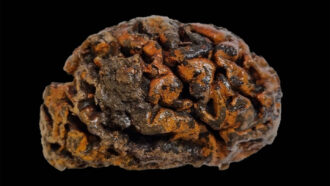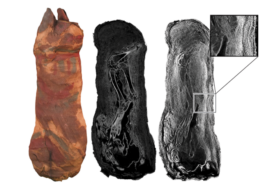anthropologist: A social scientist who studies humankind, often by focusing on its societies and cultures.
chemical: A substance formed from two or more atoms that unite (bond) in a fixed proportion and structure. For example, water is a chemical made when two hydrogen atoms bond to one oxygen atom. Its chemical formula is H2O. Chemical also can be an adjective to describe properties of materials that are the result of various reactions between different compounds.
conservator: A person in charge of protecting and/or restoring valuable items.
CT scan: (Also known as a CAT scan). The term is short for computerized axial tomography. It is a special type of X-ray scanning technology that produces cross-sectional views of the inside of a bone or body.
fiber: Something whose shape resembles a thread or filament.
microscope: An instrument used to view objects, like bacteria, or the single cells of plants or animals, that are too small to be visible to the unaided eye.
mummy: A body preserved by natural processes or human technology, with some skin and organs remaining.
muscle: A type of tissue used to produce movement by contracting its cells, known as muscle fibers. Muscle is rich in protein, which is why predatory species seek prey containing lots of this tissue.
organ: (in biology) Various parts of an organism that perform one or more particular functions. For instance, an ovary is an organ that makes eggs, the brain is an organ that makes sense of nerve signals and a plant’s roots are organs that take in nutrients and moisture.
palm: A type of evergreen tree that sprouts a crown of large fan-shaped leaves. Most of the roughly 2,600 different species of palms are tropical or semitropical.
resin: A sticky, sometimes aromatic substance, often secreted by plants. It may also be the viscous starting ingredient for some plastics that will harden when heated or treated with light.
stress: (in psychology) A mental, physical, emotional or behavioral reaction to an event or circumstance.








